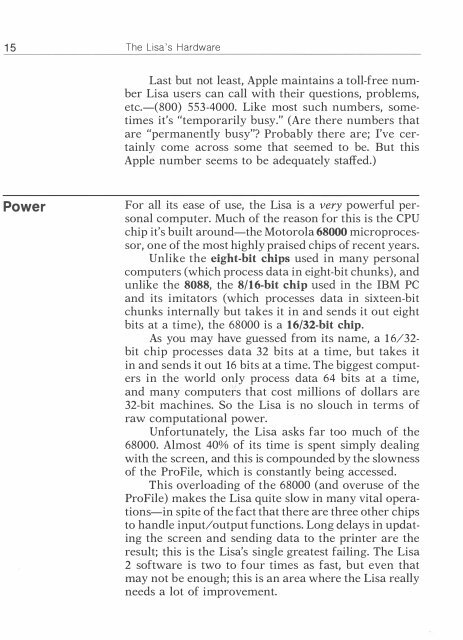naiman-1984-introduction-to-the-lisa
naiman-1984-introduction-to-the-lisa
naiman-1984-introduction-to-the-lisa
- No tags were found...
Create successful ePaper yourself
Turn your PDF publications into a flip-book with our unique Google optimized e-Paper software.
15<br />
The Lisa's Hardware<br />
Last but not least, Apple maintains a <strong>to</strong>ll-free number<br />
Lisa users can call with <strong>the</strong>ir questions, problems,<br />
etc.-(800) 553-4000. Like most such numbers, sometimes<br />
it's "temporarily busy." (Are <strong>the</strong>re numbers that<br />
are "permanently busy" Probably <strong>the</strong>re are; I've certainly<br />
come across some that seemed <strong>to</strong> be. But this<br />
Apple number seems <strong>to</strong> be adequately staffed.)<br />
Power<br />
For all its ease of use, <strong>the</strong> Lisa is a very powerful personal<br />
computer. Much of <strong>the</strong> reason for this is <strong>the</strong> CPU<br />
chip it's built around-<strong>the</strong> Mo<strong>to</strong>rola 68000 microprocessor,<br />
one of <strong>the</strong> most highly praised chips of recent years.<br />
Unlike <strong>the</strong> eight-hit chips used in many personal<br />
computers (which process data in eight-bit chunks), and<br />
unlike <strong>the</strong> 8088, <strong>the</strong> 8/16-hit chip used in <strong>the</strong> IBM PC<br />
and its imita<strong>to</strong>rs (which processes data in sixteen-bit<br />
chunks internally but takes it in and sends it out eight<br />
bits at a time), <strong>the</strong> 68000 is a 16/32-hit chip.<br />
As you may have guessed from its name, a 16/32-<br />
bit chip processes data 32 bits at a time, but takes it<br />
in and sends it out 16 bits at a time. The biggest computers<br />
in <strong>the</strong> world only process data 64 bits at a time,<br />
and many computers that cost millions of dollars are<br />
32-bit machines. So <strong>the</strong> Lisa is no slouch in terms of<br />
raw computational power.<br />
Unfortunately, <strong>the</strong> Lisa asks far <strong>to</strong>o much of <strong>the</strong><br />
68000. Almost 40% of its time is spent simply dealing<br />
with <strong>the</strong> screen, and this is compounded by <strong>the</strong> slowness<br />
of <strong>the</strong> Profile, which is constantly being accessed.<br />
This overloading of <strong>the</strong> 68000 (and overuse of <strong>the</strong><br />
Profile) makes <strong>the</strong> Lisa quite slow in many vital operations-in<br />
spite of <strong>the</strong> fact that <strong>the</strong>re are three o<strong>the</strong>r chips<br />
<strong>to</strong> handle input/ output functions. Long delays in updating<br />
<strong>the</strong> screen and sending data <strong>to</strong> <strong>the</strong> printer are <strong>the</strong><br />
result; this is <strong>the</strong> Lisa's single greatest failing. The Lisa<br />
2 software is two <strong>to</strong> four times as fast, but even that<br />
may not be enough; this is an area where <strong>the</strong> Lisa really<br />
needs a lot of improvement.


